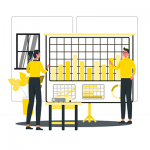What is Continuous Testing?
In today’s high-tech, modern world, innovation is driven by 3 things: speed, efficiency, and quality. This rings true across essentially every industry, and the Software Testing industry is no different. In order to stay competitive in a growing marketplace, software companies need to release their products faster, at a higher-quality, and more often. If you want to stay competitive, things like unpredictable release cycles and time-consuming manual regression suites need to become a thing of the past; you need to test earlier, test more often, and ensure that your testing is delivering high-quality feedback to your testing and development teams. But how?
Continuous Testing, of course!
Continuous Testing (CT) is a software testing practice that typically involves a process of testing early, testing often, testing everywhere, and automating your testing. It emphasizes on evaluating quality at every step of the Continuous Integration and Delivery process (CI/CD).
In Agile approaches like CI/CD, where software is frequently released to production, it is important that the software retains a high quality throughout the development, integration, and deployment, and that this is tested thoroughly, frequently and quickly.
However, despite Continuous Testing’s many benefits, some organizations are hesitant to make the transition; oftentimes, this is due to the large, up-front cost that comes along with implementing an entirely new testing process. I often urge organizations to look past the number, and think about the ROI they’ll receive in regards to quality, cost, and time.
We’ve identified 5 best practices for implementing Continuous Testing into your Software Development Lifecycle to not only improve your testing, but also your overall software quality. They are:
- Know the business goals and processes
- Emphasize collaboration between developers and testers
- Choose the best software for your niche
- Focus on quality, stability, and efficiency of the tests
- Automate!
Let’s examine each of these in more detail.
1. Know the Business Goals and Processes
Continuous Testing (CT) means testing early and frequently. In order for our CT processes to be effective for the overall business, we must ensure that we receive and understand all requirements from the business before we begin our development. Here are some tips:
- Build a good working relationship with the business analysts and domain experts—this is important for test development and Automation, and for interpreting test results.
- Address vagueness from user stories. It should contain enough information to base a comprehensive set of effective tests on.
- Do not ignore non-functional testing for areas like security and performance.
- Build meaningful end-to-end test scenarios. They will usually cross the borders of a single sprint. Careful analysis of the functionality under test and cooperation with business analysts and/or domain experts can help do this.
- Focus on providing value for the business by knowing what needs to be tested, and organizing testing in a lean and mean manner. Tests should be effective without becoming unnecessary lengthy. Communication is essential to making sure that both the team and relevant stakeholders outside the team are on the same page about what is being tested.
2. Emphasize Collaboration Between Testers and Other Team Members
In most projects, developers test the software over and over again, typically using Unit Testing. Further, into the process, there are other higher-level tests, like integration tests and business tests. Even though those are usually designed and performed by dedicated team members, they are also team products, and the whole team takes ownership of the tests and the overall system quality.
Collaboration is key to ensure that requirements and functionalities are tested properly and the end product is acceptable to be used by the end-users. Examples of cooperation can be:
- Testers and developers can work together to design unit tests and fit them in the overall test design.
- Reducing unnecessary testing artifacts—like carrying out extensive test cases and test plans—should be kept in mind. This can be modeled by the Lean Software Development principle of Eliminate Waste, which regards everything not adding value to the customer as waste; unnecessary documentation, like a traditional test plan, is one of the most common forms of waste today. But, rather than cut your test plan altogether, make it Lean and eliminate all of the unnecessary aspects; you can learn more about this modern approach to a test plan in Michael Hackett’s eBook, Reinventing Test Plans.
- Optimizing your test suite by identifying which tests are actually needed, and which are not. An approach like LogiGear’s Action-Based Testing (ABT) provides organizations with a systematic approach to test design that increases success and efficiency in Automation. To get a fuller understanding of what ABT is and how it works, check out this infographic we created.
- Adopting an investigative attitude towards testing, and the system under test.
Many teams follow a test-driven development, in which test designs help the team develop software more effectively.
3. Choose the Best Tools for Your Situation
There is no shortage of Test Automation tools on the market. However, selecting the tool that works best for your organization is contingent on many things. Often, organizations have trouble looking past the huge, upfront costs that many Test Automation tools require yet, there are so many other factors for determining success in Test Automation! Consider the long-term costs of an in-house manual test team, such as salary, infrastructure, and resources – not forgetting to mention the time it takes to run a manual test suite. You’ll also want to take into account your team’s skillset: Does your team know how to automate? Does your team have coding knowledge? These are all aspects you’ll need to take into account when your organization makes the strategic decision of implementing another tool. There are many options for tools-like LogiGear’s TestArchitect, which features codeless Test Automation – to support your needs, but finding a good fit can be a challenge.
When choosing a Test Automation tool for Continuous Testing, here are a few things to keep in mind:
- With the right tooling, continuous testing can be very helpful in providing an error-free solution, and keep it that way, especially in areas like mobile, where businesses often try to differentiate themselves from their competition with continuously delivered good software.
- Choosing the best solution that can help reach business goals and effectively integrates continuous testing tooling with the other tools the teams are using
- Note that popular tools for the system development pipeline allow for “plugins”, pieces of software that enhance the functionalities of the main tools
- Effective reporting is another key to testing success. Choose a Continuous Testing solution that provides an informative dashboard for not only management and top-level sponsors, but also the “down and dirty” project teams and developers as well.
4. Focus on quality, stability, efficiency of the tests
In CT, tests are considered an essential condition for the success of a project. Tests need to be comprehensive, but also efficient, and their automation must not break the pipeline. In my experience: if the tests are well, the project is well.
- Pay attention to test quality. For example, fellow team members, product owners, domain experts, and the like can help create and review good cases for testing
- Adequate reporting on the quality of tests increases their usefulness. For example were important areas missed, leading to issues only coming out late in the cycle, or even after release?
When an issue is found in a late-stage, ask these questions, in this order:
- Is this reported issue really a bug?
- What is the root cause?
- Why did we miss it in the testing?
- Take a more analytical approach to Software Testing in order to truly understand not only what you’re testing, but also the system under test. This is also referred to as “exploratory testing,” and treats Software Testing essentially as a learning experience.
5. Automate!
Continuous Testing (CT) can follow a test early and test often approach, which is oftentimes referred to as shift-left. Shift-left is a testing methodology in which testing is moved “left” (aka, sooner) in the SDLC, as opposed to its historical position at the end of the SDLC. By testing sooner and more often, test teams can ensure that testing does not become a bottleneck that holds up releases; it also helps in uncovering bugs and defects sooner, which allows for them to be fixed sooner in the SDLC, when it is typically cheaper, easier, and-quite frankly-less of a headache to fix. When you shift-left your testing, you also delegate some of the testing responsibility to the development team; most of the testing that the development team is responsible for revolves mainly around build validation and ensuring only high-quality builds get promoted, but with this responsibility comes 2 major benefits: (1) it fosters more communication and collaboration between teams, and (2) it frees up your testing team and allows them to perform more exploratory tests to better understand the system under test.
When it comes to Continuous Testing, Automated Testing is a necessity. In CT, the name of the game is feedback, feedback, and more feedback. Automated Testing is useful in order to get quick feedback on the application quality in any stage of the process. When incorporating Automation, here are some tips:
Making Test Automation, just like test design, a team responsibility, mainly shared by Developers, Testers, and Automation Engineers.
- Achieving a high automation coverage will actively help the CI/CD pipeline
- Running automated tests from a Continuous Integration (CI) server is a significant pay-off for the Automation efforts.
- Automating new functionality and stories along with development instead of leaving them for later should be a priority, so the whole team can be part of the process, within the same spring.
- Make sure continuous testing and automation can contribute to the overall automation of the CI/CD life cycles, which themselves are highly automated themselves. Human involvement in testing can contribute greatly as well, as part of exploratory testing
- Scale Automated Testing for best and most reliable results.
Summary
Continuous Testing has proven to be a useful asset to organizations who are looking to accelerate their software development and release schedules. It can prove critically helpful in fulfilling delivery schedules, speeding up your time-to-market while still providing the high-quality software your customers expect. With Automation and improved collaboration/communication between teams, you’ll be able to put the predictability back into your testing and therefore your release cycles. One of the deliverables of Continuous Testing that I feel is sometimes overlooked is knowledge; by testing earlier and testing more often, you’re able to have a more comprehensive understanding of what has been tested, what needs to be tested, what issues have arisen, what issues have been fixed, what issues need to be fixed, and so much more. The more you understand about your product, the more you can optimize your testing to deliver a high-quality product that sets you apart from the competition.














